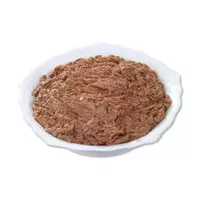Anchovy paste

Despite the fact that anchovies are often called the "silver" of Mediterranean cooking by professional culinary experts, a diametrically opposite situation has developed in modern Russian cuisine - there this miniature fish was less fortunate. This is due to the fact that anchovies are ranked both as overseas delicacies and as "garbage, " useless fish.
Often anchovies are compared with a tulip or sprat, although these are completely different fish, differing not only in taste, but also in consumer characteristics. Thus, anchovies (Engraulis) call a whole genus of pelagic fish distinguished into a separate family of the same name. Meanwhile, the main feature of anchovies is the fish's exclusively marine habitat.
In European countries, anchovies began to be used for culinary purposes at the very beginning of the Middle Ages. So, there is even certain information about the use of anchovies as food by the ancient Romans, who needed this particular fish to prepare the famous garum sauce. By the way, this ancient Roman fish sauce is considered the progenitor of numerous modern sauces, for example, Asian oyster or English Worcester sauces.
But for the first time they began to harvest anchovies for the future in France. Historians have discovered medieval French cook books describing the processes of conservation or salting of anchovies. Thanks to adjustments to scientific and technological progress in all areas of human life, including the food industry, today food abundance allows hostesses to experiment in the kitchen, using, for example, anchovy paste.
Anchovy paste, along with other similar fish products, is popular and in high demand in Europe. And today, anchovy pasta, which is tinned fish, can be a part of Worcester sauce or tapenade - the famous French snack. As a rule, high-quality vegetable oil is used for industrial production of anchovy paste. It is customary to produce anchovy paste at the so-called floating plants, where the stale fish is located immediately after catch.
Anchovy pasta has a somewhat more delicate taste than whole fish. They make it based on crushed salted aaraoycos, which are mixed with vinegar and a variety of spices. In cooking, anchovy pasta has many uses, but is mainly used as a spicy savoury seasoning.
If you want to sharpen the sauce from capers and dill, you can mix the anchovy paste with butter, and then use such a mixture to lubricate fried fish. Also, some like to add anchovy paste to salad dressings or mix it with tomato pasta sauce. True, when using anchovy paste, it should be borne in mind that half a teaspoon of this product is approximately equal to one fish fillet.
anchovy pastes 280 kCal
Energy value of anchovy paste (Ratio of proteins, fats, carbohydrates - ju):
Proteins: 26 g (~ 104 kCal)
Fats: 16g (~ 144 kCal)
Carbohydrates: 4g (~ 16kCal)
Energy ratio (bj | y): 37% | 51% | 6%
 Español
Español Français
Français Português
Português Русский
Русский 简体中文
简体中文 繁體中文
繁體中文 日本語
日本語 한국어
한국어 العربية
العربية Türkçe
Türkçe Қазақ
Қазақ Deutsch
Deutsch Italiano
Italiano Українська
Українська
